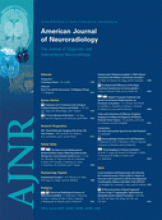Research ArticleBrain
Decrease in Leptomeningeal Ivy Sign on Fluid-Attenuated Inversion Recovery Images after Cerebral Revascularization in Patients with Moyamoya Disease
M. Kawashima, T. Noguchi, Y. Takase, Y. Nakahara and T. Matsushima
American Journal of Neuroradiology October 2010, 31 (9) 1713-1718; DOI: https://doi.org/10.3174/ajnr.A2124
M. Kawashima
T. Noguchi
Y. Takase
Y. Nakahara

References
- 1.↵
- Ohta T,
- Tanaka H,
- Kuroiwa T
- 2.↵
- Maeda M,
- Tsuchida C
- 3.↵
- Kawashima M,
- Noguchi T,
- Takase Y,
- et al
- 4.↵
- Mori N,
- Mugikura S,
- Higano S,
- et al
- 5.↵
- Iida H,
- Itoh H,
- Nakazawa M,
- et al
- 6.↵
- 7.↵
- Minoshima S,
- Berger KL,
- Lee KS,
- et al
- 8.↵
JET Study Group. Japanese EC-IC Bypass Trial (JET study): study design and interim analysis. Surg Cereb Stroke 2002; 30: 97– 100
- 9.↵
- 10.↵
- Kety SS,
- Schmidt CF
- 11.↵
- Noguchi K,
- Ogawa T,
- Inugami A,
- et al
- 12.↵
- Cosnard G,
- Duprez T,
- Grandin C,
- et al
- 13.↵
- 14.↵
- Maeda M,
- Yamamoto T,
- Daimon S,
- et al
- 15.↵
- Sanossian N,
- Saver JL,
- Alger JR,
- et al
- 16.↵
- Liebeskind DS
- 17.↵
- 18.↵
- Matsushima T,
- Inoue T,
- Suzuki SO,
- et al
- 19.↵
In this issue
Advertisement
M. Kawashima, T. Noguchi, Y. Takase, Y. Nakahara, T. Matsushima
Decrease in Leptomeningeal Ivy Sign on Fluid-Attenuated Inversion Recovery Images after Cerebral Revascularization in Patients with Moyamoya Disease
American Journal of Neuroradiology Oct 2010, 31 (9) 1713-1718; DOI: 10.3174/ajnr.A2124
0 Responses
Jump to section
Related Articles
- No related articles found.
Cited By...
- The Possible Difference of Underlying Pathophysiologies between "Ivy Sign" on Contrast-Enhanced MRI and FLAIR
- Ivy Sign in Moyamoya Disease: A Comparative Study of the FLAIR Vascular Hyperintensity Sign Against Contrast-Enhanced MRI
- FLAIR vascular hyperintensity resolution in a TIA patient: Clinical-radiologic correlation
- Moyamoya syndrome in sickle cell anaemia: a cause of recurrent stroke
- Elevated Cerebral Blood Volume Contributes to Increased FLAIR Signal in the Cerebral Sulci of Propofol-Sedated Children
This article has not yet been cited by articles in journals that are participating in Crossref Cited-by Linking.
More in this TOC Section
Similar Articles
Advertisement











